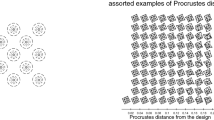Abstract
The measurement of biological forms has traditionally relied on metric measurements analyzed in terms of a suitable Cartesian space. Yet biological forms are not produced in such a framework and consequently there may be disjunction between analytical framework and biological process. A number of systems for the representation of form are examined and it is argued that all are defective, to one degree or another, at the level of congruence with biological process. Metric frameworks, it is suggested may not be sufficient and representations based on the concept of grammars and fractals are also briefly reviewed. It is concluded that representation of form in accordance with underlying structuring processes is still lacking.
Similar content being viewed by others
References
Barnsley M., 1988.Fractals Everywhere. Academic Press: New York.
Bookstein F.L., 1978.The Measurement of Biological Shape and Shape Change. Lecture Notes in Biomathematics 24. Springer: New York.
Bookstein F.L., 1982.Foundations of morphometrics. Annu. Rev. Ecology Systemat. 13: 451–470.
Bookstein F.L., Strauss R.E., Humphries J.M., Chernoff B., Elder E.L. &Smith G.R., 1982.A comment upon the use of Fourier methods in systematics. Systematic Zoology, 31: 92–95.
Bookstein F.L., 1986.Size and shape spacers for landmark data in two dimensions. Statistical Science, 1: 181–242.
Gonzalez R.C. &Thomason M.G., 1978.Syntactic Pattern Recognition: An Introduction. Addison Wesley Publishing Co.: Reading.
Freeman H., 1974.Computer processing of line drawing images. Comput. Surv. 6: 57–97.
Goodall C.R., 1983.The Statistical Analysis of Growth in Two Dimensions. Doctoral dissertation, Department of Statistics, Harvard University.
Kuhl F.P. &Giardina C.R., 1982.Elliptical Fourier features of a closed contour. Computer Graphics and Image Processing, 18: 236–258.
Leyton M., 1988.A process grammar for shape. Artificial Intelligence, 34: 213–247.
Read D., 1975.Hominid teeth and their relationship to bominid phylogeny. AJPA, 42: 105–125.
Read D., 1982.Toward a theory of archaeological classification. In: Essays on Archaeological Typology, R. Whallon and J. Brown, eds. Center for American Archaeology: Evanston, pp. 56–92.
Read D. &Lestrel P., 1986.Comment on uses of homologous point measures in systematics: A reply toBookstein et al. Systematic Zoology, 35: 241–253.
Strauss R.e. &Bookstein F.L., 1982.The truss: Body form reconstruction in morphometrics. Systematic Zoology, 31: 113–135.
Thompson D'A.W., 1961 [1917, 1942].On Growth and Form. J.T. Bonner, ed. ab. University Press: Cambridge.
Todd J.T. &Mark L.S., 1981.Issues related to the prediction of craniofacial growth. Am. J. Orthod., 79: 449–455.
Twiesselmann F., 1973.Evolution des dimensions et de la forme de la mandibule, du palais et des dents de l'homme. Annales de Paléontologie, 59: 173–277.
Author information
Authors and Affiliations
Rights and permissions
About this article
Cite this article
Read, D.W. From multivariate to qualitative measurement: Representation of shape. Hum. Evol. 5, 417–429 (1990). https://doi.org/10.1007/BF02435592
Received:
Accepted:
Issue Date:
DOI: https://doi.org/10.1007/BF02435592




